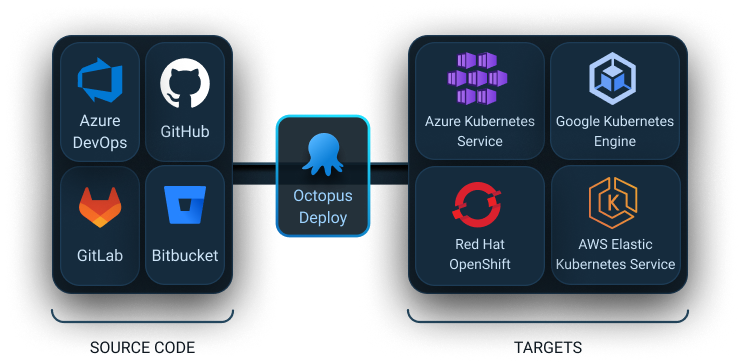Octopus Deploy makes it easy to manage your Kubernetes resources, whether you’re starting simple or want complete control over a complex setup. This section has everything you need to know about using Octopus for Kubernetes CD.

Why use Octopus as your Kubernetes CD platform
- Model environments and tenants for hundreds of applications with ease.
- Work with any Kubernetes distribution in the cloud or on-premises. Source YAML or Helm charts from Git or repositories.
- Use the centralized dashboard and detailed resource status to learn the state of all your deployments and clusters in an instant.
- Use configuration templates across environments, tenants, or even applications.
- Automate routine maintenance and respond faster to emergencies:
Getting started
With Octopus, you can choose between managing your application configuration with Helm charts or YAML.

Helm deployment guide
Learn more about how you can use Octopus variables for Helm values in our Helm documentation.

YAML deployment guide
Start with our YAML deployment guide if you intend to use plain YAML.

Kustomize with Octopus
Consider using Kustomize with Octopus for more templating capabilities.

Use the Octopus UI
You can also create a configuration with our UI, and Octopus will generate YAML behind the scenes for you.
First production deployment
When you’re ready to apply Octopus to a real scenario, we recommend that you:
- Familiarize yourself with 3 fundamental Octopus concepts: projects, environments, and targets. When you have time, you can learn about other Octopus concepts in our glossary.
- Learn how to implement GitOps best practices with Octopus and use our observability features.
Deployments at scale
Learn more about deploying to multiple apps with Octopus, with these guides:
- Release triggers [link] and channels to automate deployments
- Step templates to create new pipelines with ease
- Configuration as Code to manage deployment pipeline versions
- Users, roles, and teams
- Maintenance tasks with runbooks and scripts
Learn more
- Learn more about Kubernetes deployments with Octopus
- How to choose between Kubernetes deployment targets
- Learn more about Kubernetes on our blog
Help us continuously improve
Please let us know if you have any feedback about this page.
Page updated on Tuesday, March 26, 2024
